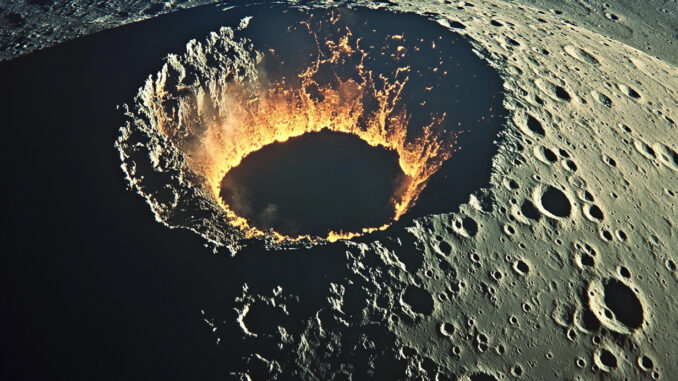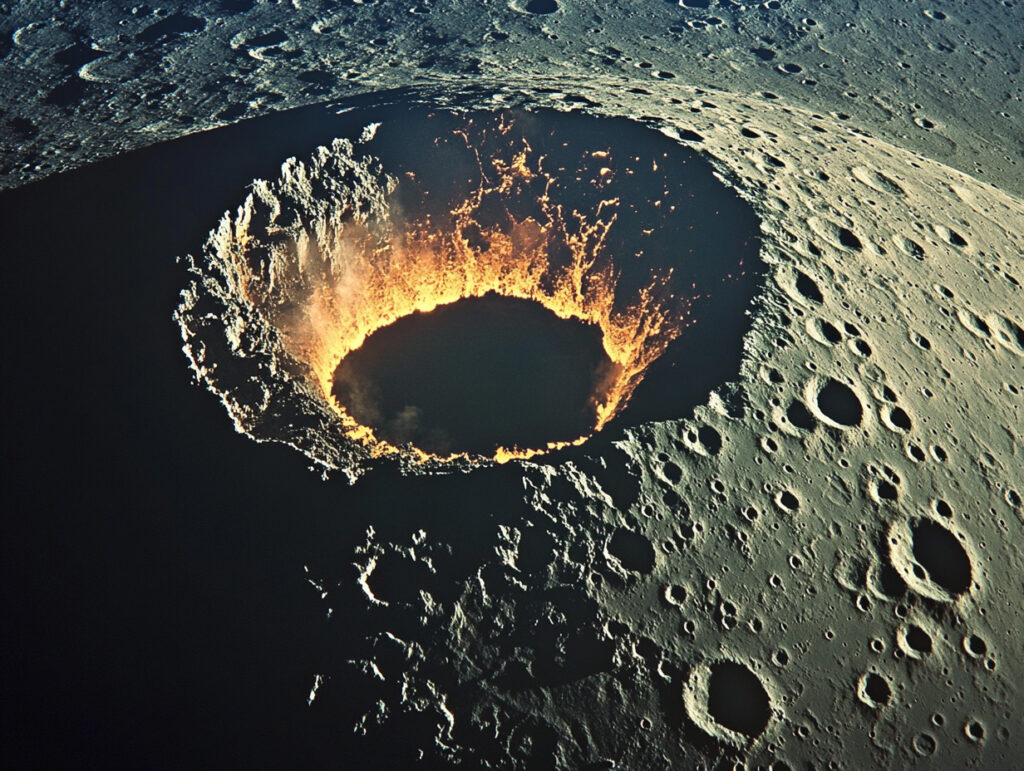
The Chang’e 5 mission reveals recent volcanic activity on the Moon, dating back only 120 million years.
New analyses of lunar samples brought back by China’s Chang’e 5 mission reveal that the Moon has experienced much more recent volcanic activity than previously thought. While the scientific community believed that lunar volcanoes had died out around 2 billion years ago, volcanic fragments dating back 120 million years have been discovered. These results suggest that certain areas of the Moon were still active in geologically recent times, probably due to abnormally high concentrations of radioactive elements generating heat. This discovery challenges our understanding of the Moon’s evolution.
Recent volcanic activity on the Moon: evidence from Chang’e 5
Analysis of lunar samples collected by China’s Chang’e 5 mission has revealed recent volcanic activity on the Moon, which is thought to have occurred only 120 million years ago. This is a surprising discovery, as scientists had thought that lunar volcanoes had been inactive for around 2 billion years. The samples brought back by Chang’e 5 come from the region known as Oceanus Procellarum, a vast basaltic plain on the visible side of the Moon, where traces of volcanic activity had already been observed.
The main hypothesis to explain this recent activity is the presence of a higher concentration of radioactive elements in certain parts of the lunar interior. These elements, such as uranium, thorium and potassium, generate heat by radioactive decay, which could have kept areas hot enough for volcanic eruptions long after volcanism had died out in other regions of the Moon.
This discovery is important because it provides clues about the Moon’s internal structure and how heat was dissipated over time. It also challenges our understanding of the geological evolution of small celestial bodies, suggesting that internal heating processes may continue for much longer than previously thought.
The importance of the Chang’e 5 samples in the study of lunar volcanism
The Chang’e 5 mission marked a turning point in lunar research by bringing back samples of lunar soil and rock to Earth for the first time since the Apollo missions and the Soviet probes of the 1970s. These samples allow scientists to carry out detailed laboratory analyses that are not possible with satellite data alone.
Among the samples collected, three small volcanic droplets were identified as being of volcanic origin and dating from 120 million years ago. These droplets, formed during eruptions of lava fountains similar to those observed in Hawaii, provide the first physical evidence of late volcanic activity on the Moon. They were probably projected long distances from the original volcanic vent, which explains why they were found far from the main lava flows present at the Chang’e 5 landing site.

This discovery could lead scientists to revise their estimates of the Moon’s thermal evolution and to rethink the role that radioactive elements could play in prolonging volcanic activity on small planets and moons. In addition, the study of these samples provides valuable information on the chemical composition of lunar rocks, leading to a better understanding of the processes that led to the formation of the “maria ’ (basalt plains formed by lava flows) on the lunar surface.
Comparison with other volcanic bodies in the Solar System
Volcanic activity on the Moon is also compared with that of other rocky bodies in the Solar System, such as the Earth, Mars, Venus and the moons of Jupiter, in particular Io. While the Earth and Venus are currently active, volcanic activity on Mars appears to be much more sporadic, with eruptions occurring every few million years. On the other hand, Io, which is similar in size to the Moon, is extremely active due to the gravitational tidal forces exerted by Jupiter, generating considerable internal heat.
The Moon and Mercury, which are smaller than Mars and Venus, should have lost their internal heat much more quickly, which explains why most scientists thought that volcanic activity had ceased billions of years ago. However, recent discoveries from Chang’e 5 show that the Moon may have retained active areas for longer than expected, probably due to high concentrations of radioactive elements in specific regions.
This raises questions about how heat is distributed and conserved in small celestial bodies. For example, on Mars, large lava flows can be dated by counting the impact craters on their surface, a technique used to estimate periods of volcanic activity. This method, also used for the Moon, may not be as accurate as expected, especially in regions where volcanism may have been more recent or more sporadic.
The implications of the new discoveries for lunar geology
The results of the Chang’e 5 mission could lead to a major revision of our understanding of lunar geology. Until now, the prevailing theory has been that the Moon lost most of its internal heat around 2 billion years ago, causing its volcanic activity to cease. The discovery of volcanic droplets dating back 120 million years suggests that certain regions continued to be active for a much longer period.
This new perspective could also have implications for other moons and planets in the Solar System. If radioactive elements can prolong volcanic activity on the Moon, it is possible that other small celestial bodies, which were supposed to be inactive, have also experienced recent volcanic episodes. Future missions, particularly those aiming to bring back samples from Mars or the moons of Jupiter such as Europe, could reveal similar geological processes.
In addition, the discovery of late volcanism on the Moon could influence future space exploration projects. If certain regions of the Moon are still thermally active, this could have an impact on strategies for colonising or mining the Moon, particularly for extracting volatile materials or energy resources potentially enriched by volcanic activity.
Towards a revision of the Moon’s volcanic history
The Chang’e 5 mission has provided convincing evidence of recent volcanic activity on the Moon, challenging the established view that the Moon has been geologically inactive for 2 billion years. These new findings show that the Moon may have retained pockets of heat in specific regions, fuelled by radioactive elements, allowing volcanic eruptions to occur as recently as 120 million years ago.
These results open up new perspectives for scientific research on the Moon and other volcanic bodies in the Solar System. They also show the importance of sample return missions, which provide precise data and a better understanding of the geological processes at work over very long periods of time.
War Wings Daily is an independant magazine.